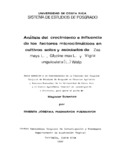Análisis del crecimiento e influencia de los factores microclimáticos en cultivos solos y asociados de Zea mays L., Glycine max L. y Vigna unguiculata (L.) Walp
Date
1985Author
Fuenmayor Fuenmayor, E.J.
xmlui.dri2xhtml.METS-1.0.item-location
Turrialba, Costa Rica
Type
Tesis de maestría
Metadata
Show full item recordAlternative title
Growth analysis and influence of microclimatic factor in mono cultures and associated cultures of Zea mays L., Glycine max L. and Vigna unguiculata (L.) Walp.
Description
Tesis (Mag. Sc.) -- CATIE, Turrialba (Costa Rica), 1985
Abstract
Para evaluar patrones de crecimiento y condiciones microclimáticas en las asociaciones de maíz con caupí y soya, en Turrialba, Costa Rica, durante Junio a Diciembre de 1984 se sembraron variedades de maíz de porte mayor e intermedio (tuxpeño y maicito), variedades de caupí de crecimiento determinado e indeterminado (Selección 288 y TVU-401) y una variedad de soya (PK-7394), con sus respectivos monocultivos. Se hizo un análisis factorial considerando tres arreglos cronológicos (simultánea 20 y 80 días de la siembra del maíz). Los patrones de crecimiento de maíz están influenciados por la variedad de maíz y la época de competencia del cultivo asociado. El maíz var. tuxpeño en promedio respondió mejor que el maicito. El asocio con caupí (TVU-401) en siembra simultánea y 20 días después produjo las mayores modificaciones a los patrones de crecimiento del tuxpeño. Los patrones de crecimiento del caupí, fueron afectados por la época de siembra, mientras la variedad de crecimiento determinado tiende a disminuir en sus patrones de biomasa, la variedad indeterminada tiende a aumentar. En soya no se muestran diferencias por efecto de épocas. Los patrones de crecimiento de los cultivos asociados al maíz, presentaron variaciones de acuerdo al grado de competencia impuesto por el cultivo dominante, definido por las características morfológicas y estructurales de las variedades de maíz y, por el arreglo cronológico en relación al patrón de crecimiento del maíz. La radiación solar no interceptada por el cultivo de maíz, resultó el factor más importante en las variaciones micro-ambientales. No se encontraron diferencias importantes en los otros factores ambientales estudiados, ni en el movimiento de agua en el suelo. Growth patterns and microclimatic conditions were evaluated with maize, cowpea and soybeans growing in association during June to Decembre 1984, in Turrialba, Costa Rica. Tall and intermediate maize varieties (tuxpeño and maicito), determinate and indeterminate cowpeas varieties (selection 288 and TVU-401), and soybean variety (PE 7394) were planted together and as monocultures. A factorial analysis was conducted, considering three chronological arrangements (0, 20, 80 days after maize planting). The pattern of maize was influenced by maize variety and period of competition with the associated crop. The response of the maize var. tuxpeño in average was better than var. maicito., The association of cowpea (TVU-401), in planted simultaneouly and 20 days after, with maize induced the greatest modifications in the growth pattern of maize var. tuxpeño, The growth patterns of cowpea were affected by the time of seeding. The determinate growth variability tends to diminish the biomass patterns, while the indeterminate variability tends to increase. Soybeans were not significantly effected by seeding time. The growth patterns in crops associated with maize varied according to the degree of competence imposed by the dominant crop. This was defined by the morphological and structural characteristics of the maize varieties used and by chronological arrangement in relation to the growth pattern of maize. solar radiation was the most significative factor in relation to the micro-environment variabilities. No important differences were detected in other environmental factors studied, including water movement in the soil.
Keywords
COSTA RICA, ZEA MAYS, GLYCINE MAX, VIGNA UNGUICULATA, MIXED CROPPING, INTERCROPPING, MONOCULTURE, PLANT DEVELOPMENTAL STAGES, CLIMATIC FACTORS, MICROCLIMATEZEA MAYS, GLYCINE MAX, VIGNA UNGUICULATA, CULTIVO MIXTO, CULTIVO INTERCALADO, MONOCULTIVO, ETAPAS DE DESARROLLO DE LA PLANTA, FACTORES CLIMATICOS, MICROCLIMA,
Publisher
Universidad de Costa Rica, San José (Costa Rica) Centro Agronómico Tropical de Investigación y Enseñanza (CATIE)
URI (Permanet link to cite or share this item)
https://repositorio.catie.ac.cr/handle/11554/332Collections
- Tesis [3111]


